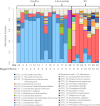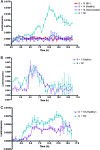Influence of the vaginal microbiota on toxic shock syndrome toxin 1 production by Staphylococcus aureus
- PMID: 23315732
- PMCID: PMC3592239
- DOI: 10.1128/AEM.02908-12
Influence of the vaginal microbiota on toxic shock syndrome toxin 1 production by Staphylococcus aureus
Abstract
Menstrual toxic shock syndrome (TSS) is a serious illness that afflicts women of premenopausal age worldwide and arises from vaginal infection by Staphylococcus aureus and concurrent production of toxic shock syndrome toxin-1 (TSST-1). Studies have illustrated the capacity of lactobacilli to reduce S. aureus virulence, including the capacity to suppress TSST-1. We hypothesized that an aberrant microbiota characteristic of pathogenic bacteria would induce the increased production of TSST-1 and that this might represent a risk factor for the development of TSS. A S. aureus TSST-1 reporter strain was grown in the presence of vaginal swab contents collected from women with a clinically healthy vaginal status, women with an intermediate status, and those diagnosed with bacterial vaginosis (BV). Bacterial supernatant challenge assays were also performed to test the effects of aerobic vaginitis (AV)-associated pathogens toward TSST-1 production. While clinical samples from healthy and BV women suppressed toxin production, in vitro studies demonstrated that Streptococcus agalactiae and Enterococcus spp. significantly induced TSST-1 production, while some Lactobacillus spp. suppressed it. The findings suggest that women colonized by S. aureus and with AV, but not BV, may be more susceptible to menstrual TSS and would most benefit from prophylactic treatment.
Figures



Similar articles
-
Vaginal community state types (CSTs) alter environmental cues and production of the Staphylococcus aureus toxic shock syndrome toxin-1 (TSST-1).J Bacteriol. 2024 Mar 21;206(3):e0044723. doi: 10.1128/jb.00447-23. Epub 2024 Feb 9. J Bacteriol. 2024. PMID: 38334326 Free PMC article.
-
Persistence survey of toxic shock syndrome toxin-1 producing Staphylococcus aureus and serum antibodies to this superantigen in five groups of menstruating women.BMC Infect Dis. 2010 Aug 23;10:249. doi: 10.1186/1471-2334-10-249. BMC Infect Dis. 2010. PMID: 20731864 Free PMC article.
-
Impact of Currently Marketed Tampons and Menstrual Cups on Staphylococcus aureus Growth and Toxic Shock Syndrome Toxin 1 Production In Vitro.Appl Environ Microbiol. 2018 May 31;84(12):e00351-18. doi: 10.1128/AEM.00351-18. Print 2018 Jun 15. Appl Environ Microbiol. 2018. PMID: 29678918 Free PMC article.
-
On the pathogenesis of toxic shock syndrome.Rev Infect Dis. 1987 Sep-Oct;9 Suppl 5:S482-9. doi: 10.1093/clinids/9.supplement_5.s482. Rev Infect Dis. 1987. PMID: 3317745 Review.
-
Epidemiology of toxic shock syndrome toxin-1 harboring Staphylococcus aureus obtained from clinical samples in Iran: A Systematic Review and Meta-analysis.Ann Ig. 2018 Sep-Oct;30(5):391-400. doi: 10.7416/ai.2018.2239. Ann Ig. 2018. PMID: 30062367
Cited by
-
In Vitro Probiotic Properties of Lactobacillus salivarius MG242 Isolated from Human Vagina.Probiotics Antimicrob Proteins. 2018 Jun;10(2):343-349. doi: 10.1007/s12602-017-9323-5. Probiotics Antimicrob Proteins. 2018. PMID: 28861766
-
Manipulation of Innate and Adaptive Immunity by Staphylococcal Superantigens.Pathogens. 2018 May 29;7(2):53. doi: 10.3390/pathogens7020053. Pathogens. 2018. PMID: 29843476 Free PMC article. Review.
-
The murine vaginal microbiota and its perturbation by the human pathogen group B Streptococcus.BMC Microbiol. 2018 Nov 26;18(1):197. doi: 10.1186/s12866-018-1341-2. BMC Microbiol. 2018. PMID: 30477439 Free PMC article.
-
17β-Estradiol Mediates Staphylococcus aureus Adhesion in Vaginal Epithelial Cells via Estrogen Receptor α-Associated Signaling Pathway.Curr Microbiol. 2023 Oct 27;80(12):391. doi: 10.1007/s00284-023-03488-6. Curr Microbiol. 2023. PMID: 37884702
-
Group B Streptococcal Maternal Colonization and Neonatal Disease: Molecular Mechanisms and Preventative Approaches.Front Pediatr. 2018 Feb 22;6:27. doi: 10.3389/fped.2018.00027. eCollection 2018. Front Pediatr. 2018. PMID: 29520354 Free PMC article. Review.
References
-
- Centers for Disease Control and Prevention 2011. Summary of notifiable diseases—United States, 2009. MMWR Morb. Mortal. Wkly. Rep. 58:1–100 - PubMed
-
- Gaventa S, Reingold AL, Hightower AW, Broome CV, Schwartz B, Hoppe C, Harwell J, Lefkowitz LK, Makintubee S, Cundiff DR, Sitze S, Toxic Shock Syndrome Study Group 1989. Active surveillance for toxic shock syndrome in the United States, 1986. Rev. Infect. Dis. 11(Suppl 1):S28–S34 - PubMed
-
- Davis CC, Kremer MJ, Schlievert PM, Squier CA. 2003. Penetration of toxic shock syndrome toxin-1 across porcine vaginal mucosa ex vivo: permeability characteristics, toxin distribution, and tissue damage. Am. J. Obstet. Gynecol. 189:1785–1791 - PubMed
-
- Shands KN, Schmid GP, Dan BB, Blum D, Guidotti RJ, Hargrett NT, Anderson RL, Hill DL, Broome CV, Band JD, Fraser DW. 1980. Toxic-shock syndrome in menstruating women: association with tampon use and Staphylococcus aureus and clinical features in 52 cases. N. Engl. J. Med. 303:1436–1442 - PubMed
Publication types
MeSH terms
Substances
LinkOut - more resources
Full Text Sources
Other Literature Sources
Molecular Biology Databases
Miscellaneous

